Production of stable aqueous dispersions of carbon nanotubes
- Summary
- Abstract
- Description
- Claims
- Application Information
AI Technical Summary
Benefits of technology
Problems solved by technology
Method used
Image
Examples
example 1
Raw material containing bundled SWCNT structures was mixed into three synthetic detergent solutions known for solubilizing proteins and lipids in aqueous solutions. The three synthetic detergents utilized were NP-40, SDS and TX-100. These detergents were selected due to their differing physical properties and to demonstrate how the surfactant activity of the detergent affects the dispersion of SWCNT structures in solution. SDS is a strong anionic detergent that solubilizes compounds in water by virtue of coating the compounds with a layer of negatively-charged, water soluble detergent molecules. In contrast, both TX-100 and NP-40 are non-ionic detergents that function via hydrophobic interactions with the surface of a compound, thereby forming a water soluble layer of detergent molecules around the water insoluble compound. The surfactant properties (i.e. ability to decrease surface tension between aqueous and non-aqueous phases) for NP-40 are much greater than SDS and TX-100. Repor...
example 2
Aqueous solutions of each of the TA, Poloxamer 188, saponin and MβC were prepared alone and with raw material as follows. Specifically, each solution was prepared by solubilizing 1 mg of the raw material in 1 ml of ddH2O containing either 50 mg / ml of TA, 50 mg / ml of MβC, 10 mg / ml of saponin or 2% (v / v) Poloxamer 188. Each resultant solution was vortexed for 30 minutes at room temperature and then filtered through a 0.2 μm cellulose acetate filter. The % T values were measured for the filtrates at room temperature immediately after filtration, 72 hr after storage in a sealed vial of the original filtered solutions and again immediately after a second filtration of the stored solutions. Dispersal agent / SWCNT-containing solutions were compared to aqueous solutions containing dispersal agent alone treated in an identical fashion.
The % T values illustrated in FIG. 2 reveals that the SWCNT structures remained dispersed in the TA, Poloxamer 188, saponin and MβC filtrates for the entire 72 ...
example 3
SWCNT structures dispersed in the TA and MβC solutions of the previous example were separated from the impurities in solution by centrifugation. Specifically, SWCNT structures sedimented out of a 1 ml volume of either solution having a liquid column height of 2.5 cm at a centrifugation speed of 10,000×g. In addition, sub-populations of SWCNT's dispersed in either NP-40, TA, MβC, saponin or Poloxamer 188 can be collected from the same sample by using sequentially increasing centrifugation speeds (e.g. 1,000×g, 2,500×g, 5,000×g and 7,500×g). As such, these results suggest that as is the case in biological separations where differential centrifugation can be used to separate cellular structures based upon their size (e.g., see Techniques Reviewed in Subcellular Fractionation—A practical approach; edited by J. M. Graham and D. Rickwood, IRL Press, Oxford, 1996), a similar approach can be utilized to collect SWCNT's of different sizes from the aqueous dispersions described here. It is no...
PUM
 Login to View More
Login to View More Abstract
Description
Claims
Application Information
 Login to View More
Login to View More - R&D
- Intellectual Property
- Life Sciences
- Materials
- Tech Scout
- Unparalleled Data Quality
- Higher Quality Content
- 60% Fewer Hallucinations
Browse by: Latest US Patents, China's latest patents, Technical Efficacy Thesaurus, Application Domain, Technology Topic, Popular Technical Reports.
© 2025 PatSnap. All rights reserved.Legal|Privacy policy|Modern Slavery Act Transparency Statement|Sitemap|About US| Contact US: help@patsnap.com



